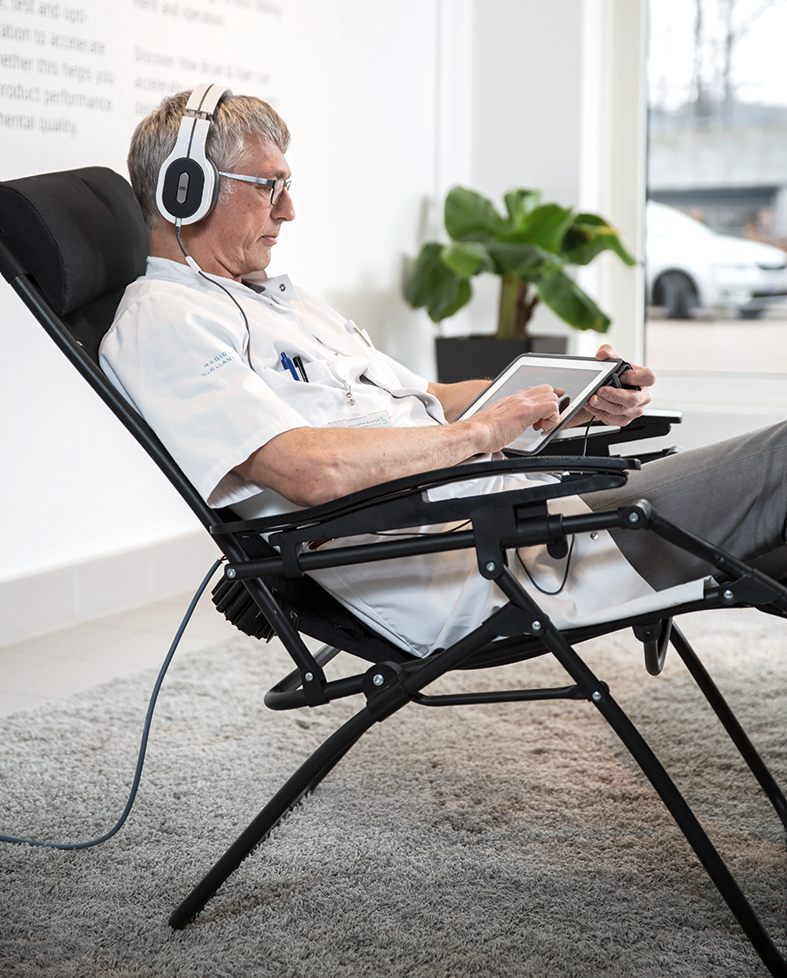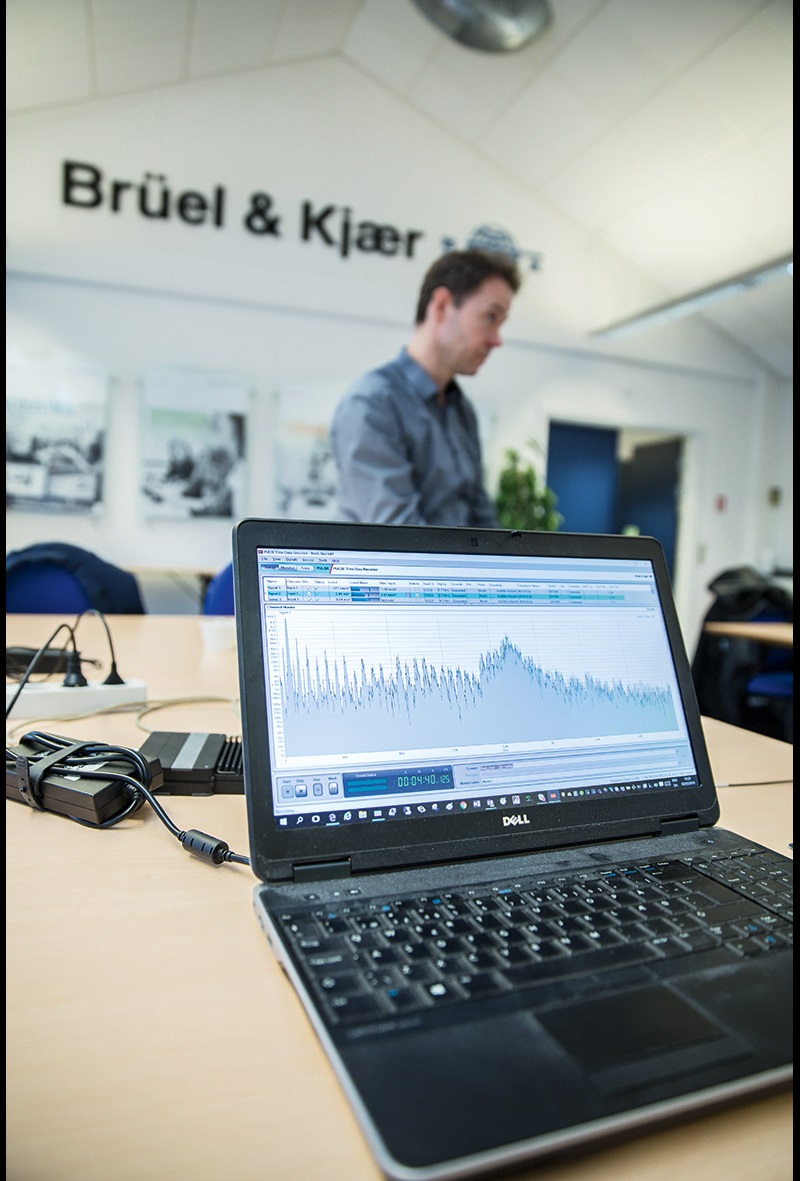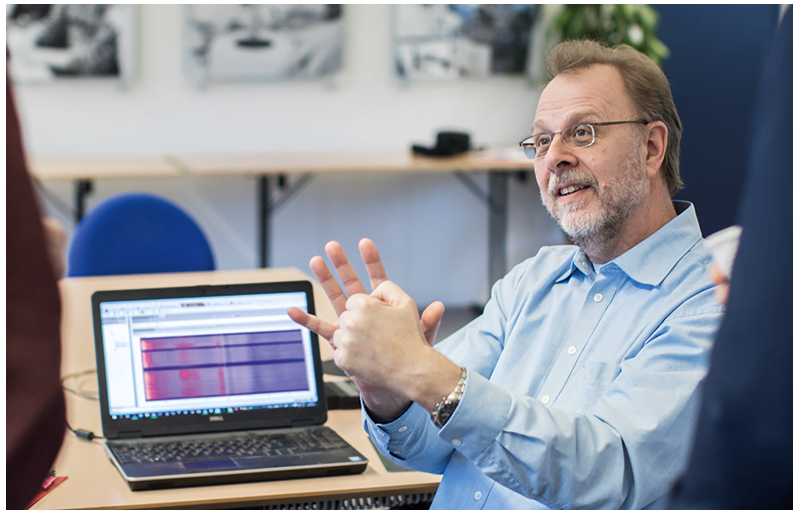Like many young Danes, Peter Michael Nielsen dreamed of rocking Roskilde musical festival…and he did just that in ’78. But he soon realized that he needed something more and strived instead to become a doctor. During this time Nielsen was still fascinated by the way that the human body perceives music, in particular the bass.
Is music the answer to pain?
Nielsen first became a neurosurgeon. After some years of opening craniums, he was haunted by a memory from a different time…when he was just 15 years old, attending organ vespers at Westminster Abbey. The performance ended on one note – a deep C – that cannot be heard by the human ear. However, everyone in attendance could sense this note through the vibrations that the intense bass created. From that moment, Nielsen understood that an important part of the sound we perceive is not audible. Subsonic frequencies are not perceived by our ears but by a system in our inner organs that detects vibration.
“Imagine an earthquake, or a herd of buffalo on the Savannah. Humans survived these events by sensing the vibrations that warned of the approaching danger,” explains Peter Michael Nielsen. “Small corpuscles consisting of one nerve fibre sense these deep vibrations and send a storm of signals to the brain. Think of it as an age-old alarm system that helped early man to survive by perceiving danger before it was audible or visible.”
During the ‘90s, MRI scans discovered that the signal pathway in the brain for both pain and vibrations was the same. Nielsen began to consider pain relief in a completely new way – could multiple low-frequency vibrations delivered to a patient potentially block pain perception, thus leaving the patient free of pain? The fact that the same procedure could potentially block depression made his research even more compelling.
Lounging towards a pain-free existence
Based on his unique understanding of music and the vibrations caused by deep bass, Nielsen invented a chair that can relieve pain. By simply sitting in the chair and using an app connected to a control station, the patient relaxes and enjoys prescribed doses of music. The music consists of two complimentary tracks played simultaneously, both composed specifically for this purpose by Nielsen himself. One of the tracks plays the type of music to which we are most accustomed, music that we can hear. In this case, the role of this track is to transport the patient to the relaxed mental state needed to perceive the second track, the bass. The second track is based on high-amplitude, low-frequency sound impulses. It is the bass in this track that has the ability to block the pain perception in the body, Nielsen found out.
> The Specially-prepared - and enjoyable - musical track (2:00)

Treatment for anyone, anywhere
“The patient feels the vibrations from the chair through a transducer,” says Nielsen. “It’s just like the transducers used in a home theatre system, so it is based on the same technology which reproduces the sensation of an earthquake at the cine-ma. And it does this without any acoustics, so the vibrations are not transmitted to the rest of the room. This makes the chair perfect for home use.”
For Nielsen, it was also vital that the audible music tracks can be enjoyed by patients from every culture and every ethnic background. As an avid music lover, he prides himself on understanding culturally diverse music styles and aims to design and produce a catalogue of tracks that please a wide audience.
“Our trials have demonstrated that patients not only experience pain relief during the session, but also remain pain free for one to two days,” says Nielsen. “The patients actually enjoy the treatment and want more – and it’s most effective if they enjoy the music that they hear. As the low-frequency vibrations block pain perceivers, it makes it a very flexible treatment that is effective for all types of pain and all types of patients.”
Assessing whole-body vibration
The test compared a specially-prepared musical track to a mathematically-produced track and assessed how comfortable the experience was. The vibrations were measured as follows:
Less than 0.315 m/s2 - Not uncomfortable
0.315 – 0.63 m/s2 - A little uncomfortable
0.5 – 1 m/s2 - Fairly uncomfortable
0.8 – 1.6m/s2 - Uncomfortable
1.25 – 2.5 m/s2 - Very uncomfortable
Greater than 2 m/s2 - Extremely uncomfortable
> Reference: ISO 2631-1, Annex C
Proven therapy, proven safety
Nielsen knew that his expert opinion was not enough, that it needed to be backed up by irrefutable, scientific proof. “My chair is not an alternative therapy device targeting the wellness market. It is a healthcare system based on sound research in psychiatry and neurology,” says Nielsen. “This is one of the reasons why I contacted Brüel & Kjær, because I wanted to find out just how much vibration is transferred to each patient and to be sure that the experience is both safe and comfortable. Now I have the scientific proof needed to demonstrate how effective my chair is – and I have even more confidence in my invention.”
For the testing at Brüel & Kjær, Nielsen used one of his specially-prepared musical tracks and compared it to a mathematically-produced track. The data was recorded using an accelerometer and PULSE Time Data Recorder software. Within the test environment, the mathematical track was perceived as being uncomfortable, whereas the musical one was perceived as being far from unpleasant.
“We know that vibrations can be unpleasant – think about people working with machinery who overdose on vibrations and can have problems with the blood vessels in their fingers,” explains Nielsen. “But this test was not just a safety measure for me. Being able to measure the vibration effect with a sensor built into the chair means that the dosage can also be measured, so the patient can increase or decrease their treatment. For me, this was the most important aspect of the test.”

A market that is ready and waiting
Around the world, 1.5 billion people suffer from chronic pain, and in 2012, there was only capacity to offer 2,500 patients in Denmark professional pain treatment. Peter Michael Nielsen has treated thousands of patients during his career and has witnessed many patients experience negative side effects from pain relief medication.
“I’ve been working on this concept for 25 years, and right now, people are probably most open to this type of treatment,” says Nielsen. “10 years ago people wanted to use the best medicine available. Now it’s changing, and people are more aware of the dangers of addiction and other potential side effects of pain medication. They want a solution that is not a drug, that is non-radiative, and without side effects.”
And what could be better than relaxing in a comfortable chair, chilling out to a truly appealing track, and walking away free of pain?

뉴스레터를 구독하고 소리와 진동에 대한 최신 이야기를 만나보세요


